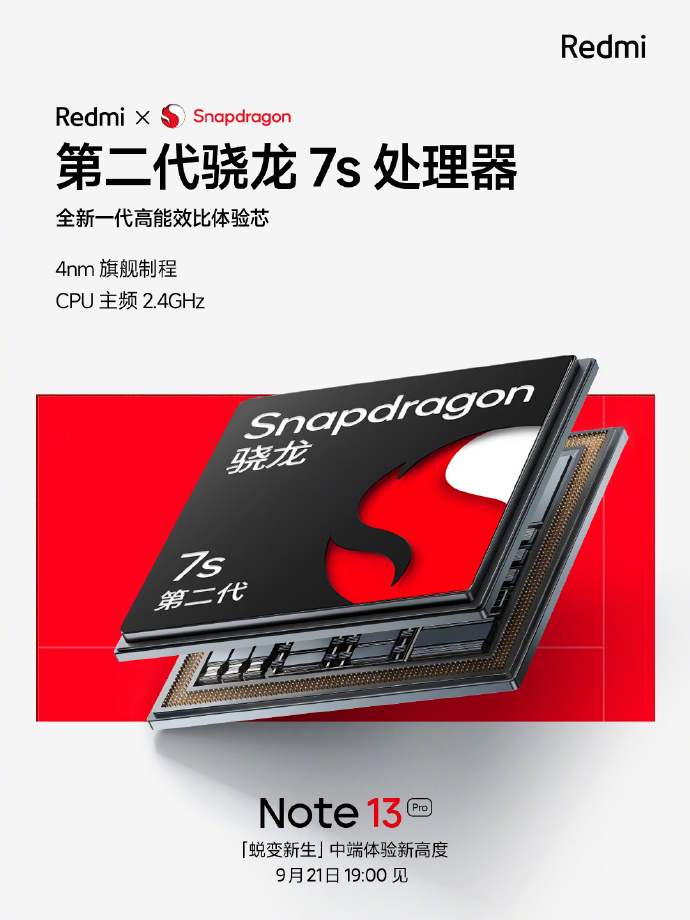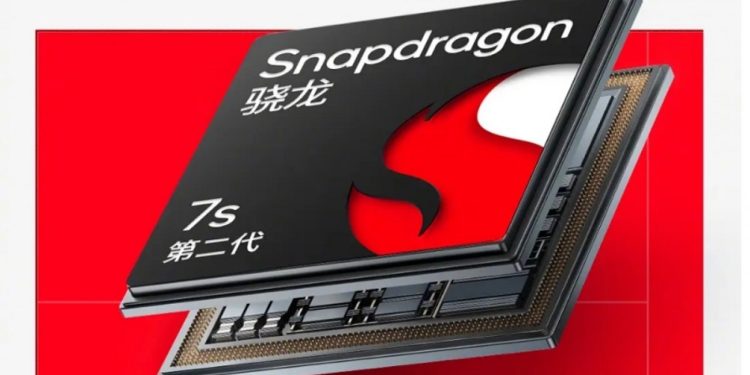US semiconductor company Qualcomm has announced its latest chipset Snapdragon 7s Gen 2. It’s based on a cutting-edge 4nm process and comprises an octa-core configuration with four cores delivering 2.4 GHz speed and the other peaking at 1.95 GHz. The SoC will debut with Xiaomi’s Redmi Note 13 Pro.
The Snapdragon 7s Gen 2 aligns with the Snapdragon 7 series built for mid-range and upper-mid-range smartphones.
This SoC comes with a Kryo CPU (64-bit architecture) mated to an Adreno GPU. It is equipped with a 12-bit Qualcomm Spectra Triple ISP (Image Signal Processor). It includes support for 4K HDR photos, an AI-based De-Noising Engine, and Qualcomm Low Light to produce better low-light images. The optics will also support Deep-Learning Face Detection and Deep-Learning Facial Landmark Detection technologies. Although the GPU has not been specified, it’s confirmed to support FHD+ resolution at 144 Hz.
Snapdragon 7s Gen 2 top features:
The S7sG2 is designed for midrange and upper midrange devices. But the bar is so high these days, that a biased perception will undermine its capabilities. This latest-generation 7S series chipset comes with support for a 200 MP camera, 4k recording, 5G, WiFi 6E, etc. Below, we highlight the most prominent features of this powerful midrange hardware.
200 MP camera, 4K recording
The Snapdragon 7s Gen 2 supports up to 200 MP single camera and 4K video recording at 30 fps and slow motion video capture at 1080p @120 fps. Not shy of AI support, the chipset consists of the Qualcomm AI Engine, Hexagon NPU, and Sensing Hub which brings aboard a number of AI capabilities.
Also, check out: Qualcomm Launches Snapdragon 8 Gen 2 Launched With Hardware Ray Tracing
5G support
Smartphone vendors can use this chipset to deliver 5G connectivity too thanks to the X62 5G Modem-RF System with support for the 3GPP Release 16 and the peak download speed of 2.9 Gbps. It features mmWave (high-band 5G) and sub-6 GHz support.
Gaming and quick charge
Likewise, the Snapdragon Elite Gaming with variable-rate shading, Quick Charge 4+, and FastConnect 6700 elevate its overall performance diversity. Other notable features include an LPDRR5 at 3200 MHz and USB-C 3.1.
Qualcomm says that the quick charge tech coming with this chipset will power smartphones from 0 to 50% in about 5 minutes.
Find out: How to Check 4G and 5G Band Support on Your Smartphone?
WiFi 6E, Bluetooth 5.2
Likewise, the chipset comes with support for up to WiFi 6E standard and Bluetooth 5.2 (with Bluetooth LE). You also get NFC, Qualcomm aptX Lossless technology, etc.
Support for LTE, WCDMA, FDD, standalone, EVDO, and mmWave-sub6 aggregation are other connectivity features.
Snapdragon 7s Gen 2 will debut with the Redmi Note 13 Pro

Upcoming mid-range smartphones will be deadly powerful and efficient
In all, the Snapdragon 7s Gen 2 is not the most powerful chipset for a smartphone. However, it ticks plenty of the boxes to offer an excellent merge of features and performance. We don’t want to imagine the upcoming mid-rangers without 5G, WiFi 6E, and high-number camera specs, do we, especially when they come with a Snapdragon chipset? Plus, the chip we are talking about is built on a 4nm process. So, it carries more computational power than those with “higher number” chipsets. The competition will also push other firms such as Samsung, MediaTek and other to up their mid-range chipset segment. This all will lead to more powerful and feature-rich smartphones in the near future.
It has been reported that the second-generation Snapdragon 7s SoC will debut with the upcoming Redmi Note 13 Pro and might also feature in other Xiaomi phones. The device is set for launch on September 21.













